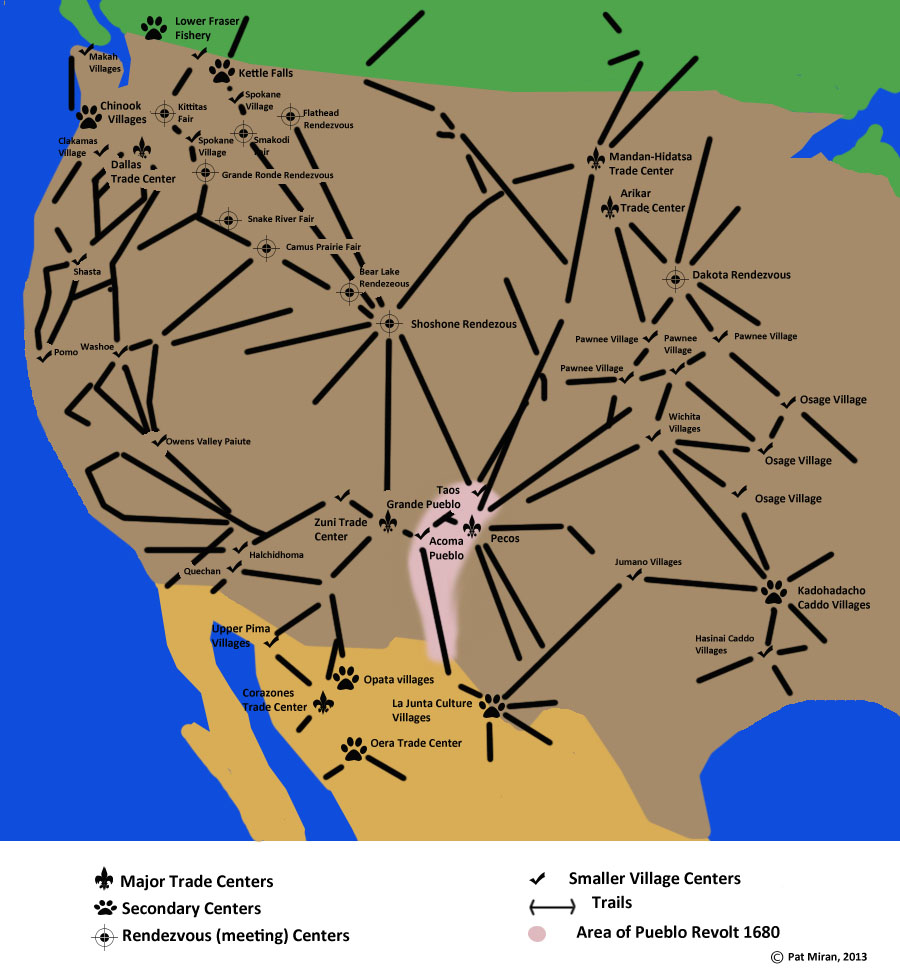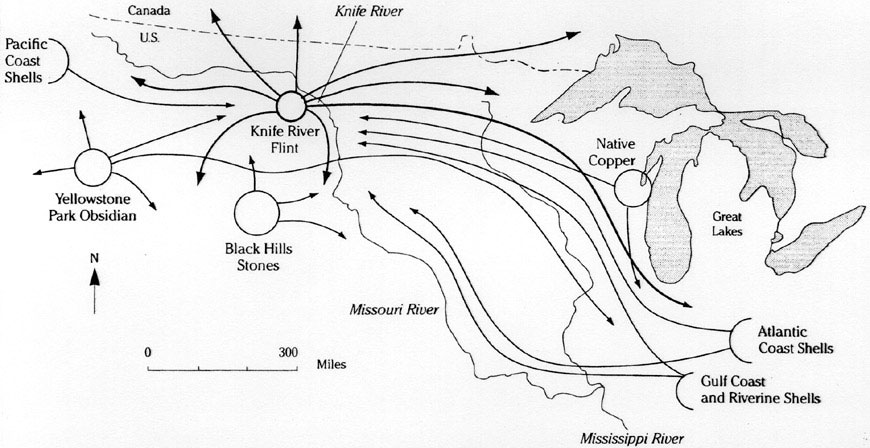
Unveiling the Arteries of Ancient America: A Deep Dive into Native American Trade Routes and Networks Exhibits
An exhibit dedicated to Native American trade routes and networks is not merely a display of artifacts; it is an immersive journey into the intricate economic, social, and cultural fabric of pre-Columbian North America. Far from isolated communities, indigenous peoples cultivated sophisticated, expansive, and enduring exchange systems that rivaled, and in some aspects surpassed, those of contemporary Old World societies. Such an exhibit aims to dismantle simplistic notions of "primitive" societies, revealing instead a continent crisscrossed by dynamic pathways of commerce, diplomacy, and cultural diffusion.
I. The Foundations of Exchange: Why Trade?
The opening section of the exhibit would establish the fundamental drivers of Native American trade, illustrating that exchange was born not solely of scarcity, but also of specialization, technological innovation, and a profound understanding of ecological diversity.
- Resource Disparity and Specialization: Interactive topographical maps, augmented with overlays indicating natural resource distribution, would immediately highlight the geographical imperative for trade. For instance, obsidian, vital for sharp tools and weapons, was primarily found in specific volcanic regions of the Southwest and Northwest. Copper, prized for ornaments and tools, originated largely from the Great Lakes region. Shells, particularly conch and dentalium, were coastal treasures. The exhibit would explain how these localized resources fostered regional specialization, where communities became adept at extracting, processing, and crafting specific goods. Interpretive panels would detail the geological origins of these materials and the ingenuity involved in their extraction and initial processing.
- Beyond Economics: Social and Diplomatic Imperatives: This section would delve into the multifaceted role of trade beyond mere economic transaction. Explanations would emphasize that trade routes were also channels for diplomacy, alliance-building, and conflict resolution. Gift-giving, a distinct form of exchange, often solidified political ties and peace treaties. Multimedia presentations would feature ethnographic accounts and archaeological interpretations highlighting how trade facilitated inter-tribal marriages, shared ceremonies, and the exchange of knowledge, songs, and spiritual practices, demonstrating its function as a powerful mechanism for social cohesion.
- Technological and Cultural Diffusion: Displays of identical tool types or artistic motifs found thousands of miles apart would visually underscore how trade served as a primary vector for technological and cultural diffusion. For example, the spread of agricultural practices (corn, beans, squash), pottery styles, and even architectural concepts (like mound building) can often be traced along established trade networks. This section would challenge the perception of static, isolated cultures, presenting a dynamic landscape of innovation and adaptation.

II. The Goods of Exchange: What Was Traded?
This core section would showcase the astonishing diversity of goods exchanged, categorized to illustrate their utilitarian, ceremonial, and luxury values. Authenticated artifacts, meticulously curated and displayed, would be the stars of this segment.
- Utilitarian Goods: Displays would feature examples of raw materials and finished tools:
- Stone: Obsidian blades, chert projectile points, basalt grinding stones. Interactive kiosks could allow visitors to virtually "trace" the origin of a specific obsidian blade from its archaeological site back to its geological source.
- Copper: Cold-hammered copper tools, awls, and fishhooks from the Great Lakes, demonstrating early metallurgy.
- Salt: Essential for preservation and diet, salt was a vital trade commodity, often sourced from specific springs or mines. Recreations of salt harvesting techniques could be depicted.
- Foodstuffs: Dehydrated berries, dried meat (pemmican), corn, beans, and squash would represent the exchange of vital sustenance, particularly important in regions with varying agricultural capacities.

- Ceremonial and Prestige Goods: This category would highlight items whose value transcended utility, often imbued with spiritual significance or serving as markers of status.
- Shells: Elaborate conch shell gorgets from the Mississippian culture, dentalium shells used as currency and ornamentation in the Pacific Northwest, and various small shells used for beads and adornment across the continent. Explanations would detail the arduous journeys required to acquire these items.
- Turquoise: Mined in the American Southwest, turquoise was highly prized for jewelry and ceremonial offerings, traded extensively into Mesoamerica and other regions. Exhibits would show raw turquoise alongside finely crafted pendants and beads.
- Exotic Feathers: Macaw and parrot feathers, originating from Mesoamerica, found in sites like Chaco Canyon, illustrate the astonishing reach of some trade networks and the value placed on exotic materials.
- Pipes: Intricately carved stone pipes, often made from pipestone (catlinite) from specific quarries, were exchanged for ceremonial purposes and symbolized diplomacy.
- Finished Products and Textiles: Pottery, baskets, and woven goods often carried distinctive regional styles, yet their presence in distant archaeological sites testifies to robust trade. Elaborate textiles, though rarely preserved, would be represented through illustrations and descriptions based on archaeological evidence.
III. Major Trade Networks and Routes: The Arteries of the Continent
This section would be dominated by large-scale, interactive maps and immersive displays, bringing the vastness and complexity of the trade networks to life.
- The Eastern Woodlands and Mississippian Networks: A grand map would illuminate the extensive riverine systems (Mississippi, Ohio, Missouri, Great Lakes) that served as natural highways. The exhibit would focus on major hubs like Cahokia (near modern-day St. Louis), a pre-eminent Mississippian city that acted as a central marketplace and redistributive center for goods flowing from the Gulf Coast (shells), the Great Lakes (copper), the Appalachians (mica), and the Rockies (obsidian). Reconstructed scenes or dioramas could depict bustling riverfront trade at Cahokia.
- The Southwestern Exchange Systems: This segment would highlight desert routes, focusing on the Ancestral Pueblo (Anasazi), Hohokam, and Mogollon cultures. The sophisticated road system radiating from Chaco Canyon would be illustrated, showcasing its role in connecting dispersed communities and facilitating the exchange of turquoise, pottery, cotton, and exotic birds. The deep connections with Mesoamerican cultures, evidenced by macaws and cacao, would be a key focus.
- The Pacific Northwest Coastal and Riverine Trade: Here, the exhibit would showcase the sophisticated maritime and river-based trade of peoples like the Haida, Tlingit, and Kwakwaka’wakw. Obsidian from volcanic peaks, dried salmon, cedar products, and dentalium shells were exchanged along intricate routes. The concept of the "potlatch" – a ceremonial feast involving extensive gift-giving and redistribution of wealth – would be explained as a crucial mechanism for reinforcing trade relationships and social status.
- The Great Plains and Inter-Regional Connections: While often seen as a resource-rich area, the Plains were a vital crossroads. Bison products (hides, meat, bone tools) were exchanged for pottery from the east, obsidian from the west, and eventually, horses from the Spanish Southwest. The exhibit would emphasize how groups like the Mandan and Hidatsa villages on the Missouri River served as significant trade centers, connecting disparate regions.
- The Interconnected Web: Crucially, the exhibit would emphasize that these were not isolated systems but interconnected webs. A final, animated map would demonstrate how goods originating in the Gulf Coast could ultimately reach the Great Lakes, or how Pacific obsidian could be found in the Plains, illustrating the "relay trade" system where goods passed through multiple hands and communities over vast distances. Interpretive panels would discuss the roles of specialized traders, trade languages, and established protocols that facilitated these long-distance exchanges.
IV. The Mechanics and Social Dimensions of Trade
This section would delve into the practicalities and societal underpinnings of Native American commerce.
- Trade Practices: Interpretive panels would explain the nuances of barter, gift-giving, and the emergence of certain goods (like wampum or dentalium shells) as forms of proto-currency or prestige items. The concept of "value" in indigenous societies, often tied to labor, scarcity, spiritual significance, and social utility, would be explored.
- The Role of Trade Fairs and Rendezvous: Recreations or illustrations of large annual trade gatherings, where hundreds or thousands of people from different nations would converge, would demonstrate the vibrant social and economic hubs these events created. These were not just markets but opportunities for cultural exchange, storytelling, and diplomatic negotiations.
- Trade Languages and Diplomacy: The development of specific trade languages (like Chinook Jargon in the Northwest or Plains Sign Language) to bridge linguistic divides would be highlighted, underscoring the sophistication of inter-tribal communication. The role of trade as a peace-keeping mechanism, where economic interdependence fostered mutual respect, would also be explored.
V. The Enduring Legacy and Impact
The concluding section would reflect on the profound and lasting impact of these trade networks.
- Cultural Resilience and Adaptation: The exhibit would culminate with a reflection on how these established networks adapted, and sometimes struggled, in the face of European contact. New goods (metal tools, firearms, glass beads) entered the system, often disrupting traditional economies and power dynamics. However, indigenous trade routes often persisted, evolving to incorporate new commodities and relationships.
- A Testament to Ingenuity: The overarching message would be one of profound appreciation for the ingenuity, adaptability, and complex societal structures of Native American peoples. Their trade routes and networks were not primitive trails but sophisticated arteries that nourished entire civilizations, facilitating not just survival but also flourishing cultures, rich spiritual lives, and dynamic inter-societal connections.
An exhibit on Native American trade routes and networks serves as a powerful testament to the enduring human drive for connection and exchange. It invites visitors to step back in time and witness the vibrant, interconnected world that existed long before European arrival, revealing a narrative of innovation, diplomacy, and cultural richness that shaped the North American continent.


